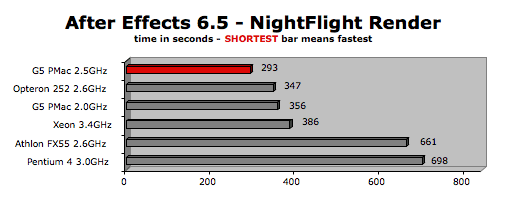
Posted on 02/19/2005 7:38:55 PM PST by Swordmaker
This is the "early 2005" version of what is consistently one of our most popular reports. I was recently invited by San Diego Supercomputer Center (SDSC) and WhisperPC to help test a Dual 3.4GHz Xeon system and a 64 bit "3500+" (2.2GHz) Athlon system. They were trying to choose a high end PC to use as their recommended workstation for themselves as well as for those remote scientists wanting to run the custom visualization software produced at SDSC and commercial applications (like Maya).
Though the G5 Power Mac wasn't being considered by SDSC, I thought it was a perfect time to refresh the "Mac versus PC" report on our site. I included the results from last year's 3GHz Pentium 4 test as a reference point. We'll test a faster Pentium 4 system as soon as it's available to us.

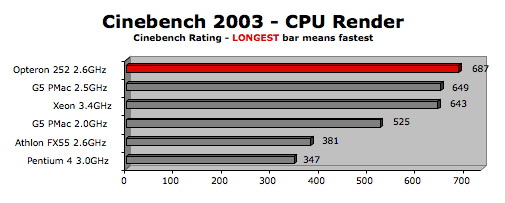
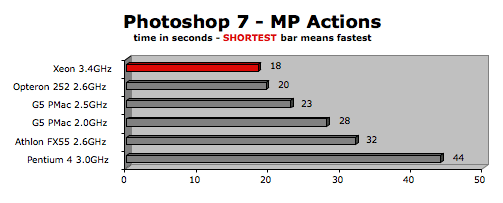
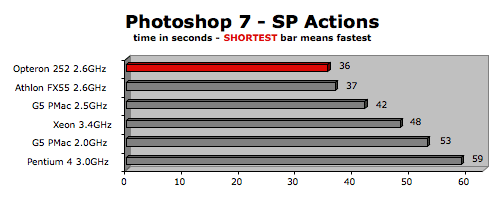
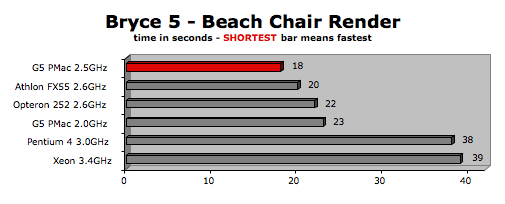
(watch this space for Maya results in a few days)
INSIGHTS and COMMENTS
1. I'm often accused of choosing applications that favor the Mac. That makes me chuckle when you consider that, when I first started the "Mac versus PC" shootouts, the G4 Power Mac only won one test: Photoshop "MP." Ironically, in this round of testing, the top G5 Power Mac (dual 2.5GHz) won every CPU intensive test except the Photoshop "MP."
2. The first three graphs above show the power of having dual processors. The last two show how non-MP "aware" apps or functions give single processor systems "equal footing" with the dual processor units. However, if you have two active non-MP aware apps running simultaneously, the Power Mac gets both processors involved. I assume the same is true of the Windows XP based systems.
3. The test units had different memory configurations ranging from 2GB to 4GB. However, since we were running one task at a time, even 1GB would have produced the same results as 4GB. But for the record, this was the configuration:
Dual G5/2.5GHz Power Mac = 4GB of 400MHz DDR
Dual G5/2.0GHz Power Mac = 4GB of 400MHz DDR
Dual Xeon 3.4GHz = 4GB of 400MHz DDR
Pentium 4 3GHz = 2GB of 400MHz DDR
64 bit Athlon 2.2GHz = 3GB of 333MHz DDR
4. The boot drives varied in speed and interface from system to system, but the tests we ran and the way we ran them did not involve any disk activity.
5. We didn't specify graphics cards on this page because the tests we ran netted the same results, no matter what card we used. In other words, we successfully isolated the CPU. There is a new trend to involve the graphics card in what has been traditionally CPU only rendering, as we have seen with Maya and Motion. We plan to add Maya results in a few days but Motion is Mac only.
Though the Dual G5 Power Macs did well against the Windows based machines in the CPU intensive tests featured on this page, the 3D graphics tests were a whole other matter. Be sure to check out our "GRAPHICS" PAGE TWO before you trade in your PC for a Mac. ;-)
And if you did build out a dual CPU system of closer to the same speeds, then the performance difference reported between the Mac and Athlon would evaporate.
The single Athlon was tested although they have done a dual 2.2 head to head last year it was removed per request to allow them to compare a 2.6 dual.
I had already included XP Professional OEM at $153 (XP home is not comparable to OSX) but the software I am refering to is the iLIFE Suite and a host of other included Mac software. To duplicate the included Mac software on the Athlon with Windows equivalents would probably cost about $1500... but then perhaps the target users wouldn't need that.
As to Windows or Linux, UH, yeah... you don't need the choice... OSX and UNIX are included with every Mac but you can also download and install LINUX if you want to. . . but I can't see why you would. UNIX you know.
Yet more PHONY Mac benchmarks. You'd think that people would remember the last few times that Mac fanatics have tried to pull this kind of crap...
Disclaimer: Opinions posted on Free Republic are those of the individual posters and do not necessarily represent the opinion of Free Republic or its management. All materials posted herein are protected by copyright law and the exemption for fair use of copyrighted works.